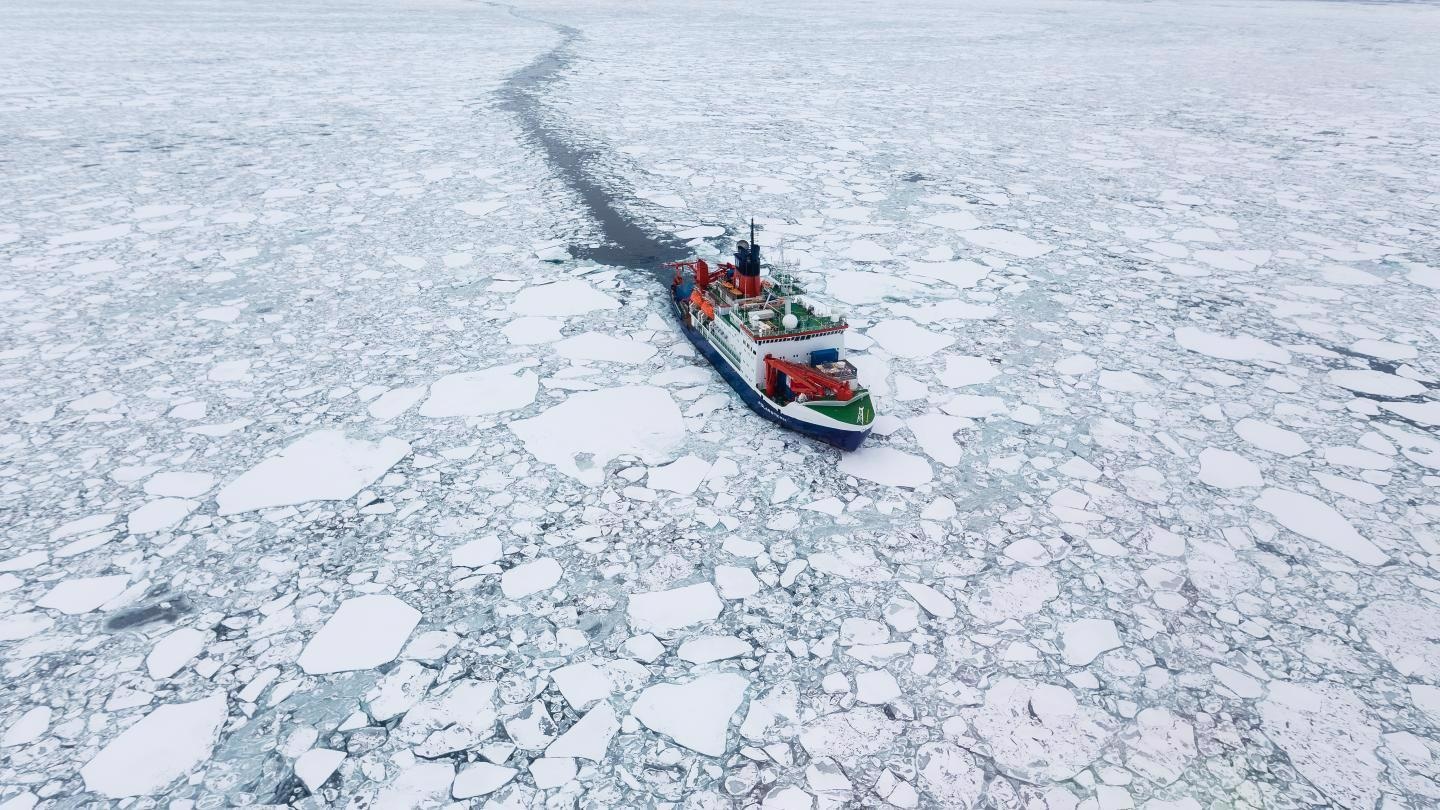Jun 4 2021
According to a new modeling study headed by researchers from the University College London (UCL), sea ice in the Arctic coastal regions may be thinning up to twice as fast as previously assumed.
 The research vessel Polarstern drifting in Arctic sea ice. Source: MOSAiC website image library https://multimedia.awi.de/mosaic/. Image Credit: Alfred-Wegener-Institut.
The research vessel Polarstern drifting in Arctic sea ice. Source: MOSAiC website image library https://multimedia.awi.de/mosaic/. Image Credit: Alfred-Wegener-Institut.
The thickness of sea ice is deduced by quantifying the height of the ice above the water, but this measurement is affected by snow weighing the ice floe down. To adjust this measurement, scientists generally use a map of snow depth in the Arctic but this method is very old and does not factor in climate change.
Now, in a new research work recently published in The Cryosphere journal, scientists exchanged this map for the results of a novel computer model developed to predict the depth of the snow as it changes year to year, and they surmised that sea ice in major coastal areas was thinning at a speed that was 70% to 100% faster than previously assumed.
The thickness of sea ice is a sensitive indicator of the health of the Arctic. It is important as thicker ice acts as an insulating blanket, stopping the ocean from warming up the atmosphere in winter, and protecting the ocean from the sunshine in summer. Thinner ice is also less likely to survive during the Arctic summer melt.
Robbie Mallett, Study Lead and PhD Student, UCL Earth Sciences
Mallett continued, “Previous calculations of sea ice thickness are based on a snow map last updated 20 years ago. Because sea ice has begun forming later and later in the year, the snow on top has less time to accumulate. Our calculations account for this declining snow depth for the first time, and suggest the sea ice is thinning faster than we thought.”
There are a number of uncertainties in measuring sea ice thickness but we believe our new calculations are a major step forward in terms of more accurately interpreting the data we have from satellites.
Julienne Stroeve, Study Co-Author and Professor, UCL Earth Sciences
Stroeve continued, “We hope this work can be used to better assess the performance of climate models that forecast the effects of long-term climate change in the Arctic—a region that is warming at three times the global rate, and whose millions of square kilometres of ice are essential for keeping the planet cool.”
To estimate the thickness of sea ice, the investigators utilized radar from the European Space Agency’s CryoSat-2 satellite. By timing the duration it takes for radar waves to reflect from the ice, the researchers can estimate the height of the ice above the water, from which they can deduce the overall thickness of the ice.
In the latest study, the investigators used an innovative snow model—called SnowModel-LG—that was earlier designed by scientists from UCL and Colorado State University.
This model calculates the depth and density of snow by using inputs, like snowfall, air temperature and ice motion data to monitor the amount of snow that builds up on sea ice as it travels around the Arctic Ocean.
Then researchers combined the outcomes of the snow model with satellite radar observations and subsequently calculated the total speed of decline of the thickness of sea ice in the Arctic region and also the variability of the thickness of the sea ice from year to year.
The researchers also observed that the speed of decline in the three coastal seas of Laptev, Kara, Chukchi increased by as much as 70%, 98% and 110%, in that order, when compared to previous calculations. The team further found that the variability in the thickness of the sea ice from year to year also increased by 58% across all seven coastal seas.
In the coastal seas, sea ice usually differs from 0.5 m to 2 m thick. But increasingly, the ice in this area is not tolerating the summer melt.
The more rapid thinning of sea ice in the coastal Arctic seas holds major implications for human activity in the area, in terms of shipping along the Northern Sea Route for a greater part of the year and also in terms of the extraction of resources from the seafloor, like minerals, gas and oil.
More ships following the route around Siberia would reduce the fuel and carbon emissions necessary to move goods around the world, particularly between China and Europe. However, it also raises the risk of fuel spillages in the Arctic, the consequences of which could be dire. The thinning of coastal sea ice is also worrying for indigenous communities, as it leaves settlements on the coast increasingly exposed to strong weather and wave action from the emerging ocean.
Robbie Mallett, Study Lead and PhD Student, UCL Earth Sciences
Mallett, Professor Stroeve, and study co-author Dr Michel Tsamados from UCL Earth Sciences had spent many weeks exploring ice and snow in the Arctic onboard the German research vessel Polarstern, which investigated the central Arctic Ocean in 2019 and 2020.
Journal Reference:
Mallett, R. D. C., et al. (2021) Faster decline and higher variability in the sea ice thickness of the marginal Arctic seas when accounting for dynamic snow cover. Cryosphere. doi.org/10.5194/tc-15-2429-2021, 2021.